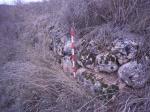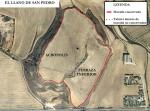Summary (English)
In 1995 J.M. Abascal published a document from the Real Academia de la Historia which considers important archaeological findings from the Carpetan and Roman periods, including a remarkable numismatic collection. This document, Memoria de las Antigüedades de Valderrebollo, was written in 1789 by F. Sepúlveda y Lucio (1825-1883), a pharmacologist and chronicler of Brihuega. This report describes the archaeological excavations carried out in the landscape surrounding the aforementioned Alcarrian town.
Through the study of this 19th century document we were able, in 2010, to recognise the site through a survey in this area under the ‘ época romana republicana en la actual provincia de Guadalajara ’, siglos II-I a. C. Project).
The newly identified oppidum is located in the Tajuña valley, precisely at the border between Celtiberia and Carpetania. The materials recovered thus far in systematic prospection demonstrate that it was a walled settlement. It’s length exceeded nine hectares, and it appears to have been inhabited until the early stages of Rome´s conquest. Regarding the occupational chronology of the site, it must be noted that certain polished axes were found, which suggests a history that reaches back to the Neolithic.
However, our excavations here have only produced sherds from the third to the first centuries BC. It was in the second century BC that the oppidum reached its greatest stage of both development and size.
The main outstanding issue is still to establish the date of the abandonment of the settlement. It appears to have been a gradual process that was first initiated in the second half of the first century BC.; given that we have not found any materials from the High-Imperial period, we believe that the settlement did not exceed the turn of the millenium. Among the 19th century numismatic findings are High-Imperial coins of a Roman mint, and Hispano-Roman coins, but their origins are unsure, and thus it is likely that some of them come from the nearby Roman Imperial site of ‘La Veguilla’.
In the area surrounding La Veguilla, in the plain located east of the oppidum, is a Roman imperial site where, according to ‘the Memory of the RAH’, was the discovery of “a multitude of rubbles of ancient pottery”… as well as …“some copper cauldrons and some little copper and bronze utensils”.
As mentioned, it is likely that some of the High-Imperial numismatic collection came of this site. In addition, local people have confirmed the existence of epigraphic findings in the plain which are still to befound.
In the immediate surroundings of the oppidum F. Sepúlveda y Lucio identified other sites of note. During our explorations we found Carpetan oxidized pottery, but it is possible that it came from hillwash.
(translation by Esther Casares Carmona)
- Emilio Gamo Pazos
Director
- Emilio Gamo Pazos (Universidad Complutense de Madrid-Departamento de Prehistoria)
Team
Research Body
- Unversidad Complutense de Madrid
Funding Body
- Junta de Comunidades de Castilla-La Mancha






![Download [PDF]](/excavation/skins/fasti/images/results/download_sml.png)

